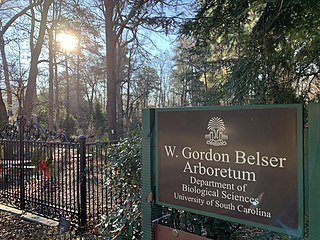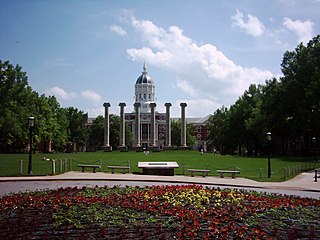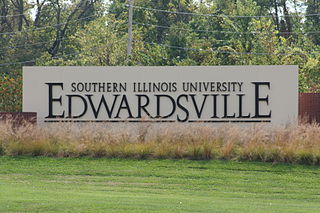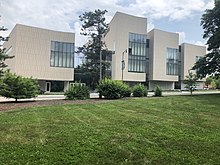
Columbia is a city in the U.S. state of Missouri. It is the county seat of Boone County and home to the University of Missouri. Founded in 1821, it is the principal city of the five-county Columbia metropolitan area. It is Missouri's 4th most populous with an estimated 128,555 residents in 2022.

Boyce Thompson Arboretum is the oldest and largest botanical garden in the state of Arizona. It is one of the oldest botanical institutions west of the Mississippi River. Founded in 1924 as a desert plant research facility and “living museum”, the arboretum is located in the Sonoran Desert on 392 acres (159 ha) along Queen Creek and beneath the towering volcanic remnant, Picketpost Mountain. Boyce Thompson Arboretum is on U.S. Highway 60, an hour's drive east from Phoenix and 3 miles (4.8 km) west of Superior, Arizona.

An arboretum is a botanical collection composed exclusively of trees of a variety of species. Originally mostly created as a section in a larger garden or park for specimens of mostly non-local species, many modern arboreta are in botanical gardens as living collections of woody plants and is intended at least in part for scientific study.

The Fullerton Arboretum is a 26-acre (11 ha) botanical garden with a collection of plants from around the world, located on the northeast corner of the California State University, Fullerton campus in Fullerton, California, in the United States. It is the largest botanical garden in Orange County, with a collection of over 4,000 plants. The Arboretum saves species that are extinct or near extinction and serves as a learning place for agricultural history.
The Edith J. Carrier Arboretum is an arboretum and botanical garden on the James Madison University campus, located in Harrisonburg, Virginia, United States in the Shenandoah Valley. Groundbreaking for the arboretum took place April, 1985, under direction of Dr. Norlyn Bodkin,[1] who is credited the first scientific botanical discovery along the Eastern Seaboard of Virginia since the 1940s, Trillium: Shenandoah Wake Robin, presently found at the arboretum[2]. The only arboretum located on the campus of a Virginia state university. Exhibits include a developed trail system through 125 acres (0.51 km2) of mature Oak-Hickory Forrest with two identified century specimens and a species on the U.S. Fish and Wildlife Threatened Species list protected at the arboretum: Betula uber, Round-Leaf Birch.[3]
The Mizzou Botanic Garden contains thousands of plants within the campus of the University of Missouri in Columbia, Missouri, United States. The Garden includes famous icons, such as Thomas Jefferson's original grave marker and the Columns of Academic Hall, and is open year-round, only asking for a small donation to visit.
The South Arkansas Arboretum is an arboretum and botanical garden owned by the local school system but operated as Arkansas's 50th state park by the South Arkansas Community College. It is located next to the former El Dorado High School in El Dorado, Arkansas, USA and open daily except for holidays.

Faurot Field at Memorial Stadium is an outdoor sports stadium in Columbia, Missouri, United States, on the campus of the University of Missouri. It is primarily used for football and serves as the home field for the Missouri Tigers' program. It is the third-largest sports facility by seating capacity in the state of Missouri, behind The Dome at America's Center in St. Louis and Arrowhead Stadium in Kansas City. In 1972, Memorial Stadium's playing surface was named Faurot Field in honor of longtime coach Don Faurot.

Hearnes Center is a 13,611-seat multi-purpose arena in Columbia, Missouri. The arena opened in 1972. It is currently home to the Missouri Tigers' wrestling and volleyball teams as well as the school's gymnastics and indoor track & field teams. It was home to the University of Missouri Tigers basketball team before Mizzou Arena opened in 2004.

The Cornell Botanic Gardens is a botanical garden located adjacent to the Cornell University campus in Ithaca, New York. The Botanic Gardens proper consist of 25 acres (10 ha) of botanical gardens and 150 acres (61 ha) of the F. R. Newman Arboretum. The greater Botanic Gardens includes 40 different nature areas around Cornell and Ithaca, covering 4,300 acres (1,700 ha).

The Missouri State Arboretum is on the campus of Northwest Missouri State University in Maryville, Missouri and contains more than 111 species of trees.

W. Gordon Belser Arboretum is part of the University of South Carolina in Columbia, South Carolina, managed by the Department of Biological Sciences. The arboretum serves as a nature preserve, field laboratory and research site for students and faculty. It is open to the public at a monthly open house. A small botanic garden features shrubs and small trees suitable for Columbia's home landscapes. The remaining landscape features southeast native trees and plant communities and is a certified Palmetto Wildlife Habitat.

The University of Missouri in Columbia, Missouri, was established in 1839. This later expanded to the statewide University of Missouri System.
The University of Missouri School of Medicine is located in the southern part of the University of Missouri campus in Columbia, Missouri. It was the first publicly supported medical school west of the Mississippi River.

The University of Missouri is a public land-grant research university in Columbia, Missouri. It is Missouri's largest university and the flagship of the four-campus University of Missouri System. MU was founded in 1839 as the first public university west of the Mississippi River. It has been a member of the Association of American Universities since 1908 and is classified among "R1: Doctoral Universities – Very high research activity".

The University of Maryland Arboretum and Botanical Garden is located on the grounds of the University of Maryland - College Park. The Arboretum and Botanical Garden is free to visit and is used as an outdoor classroom for a variety of courses at the University. There is an established Central Campus Tree Walking Tour around McKeldin Mall.

The Gardens at SIUE is a botanical garden on the campus of Southern Illinois University Edwardsville (SIUE). It originated as an arboretum and occupies a 35 acres (14 ha) tract of the university's 2,660 acres (1,080 ha) campus at Edwardsville, Illinois. It serves as a twofold function as a living laboratory dedicated in support of the educational and research missions of the university and as a place of beauty for the university community to share with the general public. In light of this duality, the gardens' master plan calls for the creation of a "public garden featuring spectacular horticulture, event spaces, areas for social gatherings and contemplative gardens" to be continuously enhanced over the coming years. The Gardens at SIUE was recognized by the Missouri Botanical Gardens as a "Signature Garden" until the MOBOT program was discontinued.

In 2015, a series of protests at the University of Missouri related to race, workplace benefits, and leadership resulted in the resignations of the president of the University of Missouri System and the chancellor of the flagship Columbia campus. The moves came after a series of events that included a hunger strike by a student and a boycott by the football team. The movement was primarily led by a student group named Concerned Student 1950. The movement and protests were documented in two films, one made by MU student journalists and the other, 2 Fists Up, by Spike Lee. While it is alleged that bad publicity from the protests has led to dropping enrollment and cutbacks, others have cited budget cuts issued from the state legislature.

Herbert R. Schaal is an American landscape architect, educator, and firm leader notable for the broad range and diversity of his projects, including regional studies, national parks, corporate and university campuses, site planning, botanical gardens, downtowns, highways, cemeteries, and public and private gardens. Schaal is one of the first landscape architects to design children's gardens, beginning in the 1990s with Gateway Elementary, Gateway Middle, and Gateway Michael Elementary school grounds in St. Louis, Missouri, the Hershey Children's Garden at the Cleveland Botanical Gardens, and Red Butte Garden and Arboretum.
















